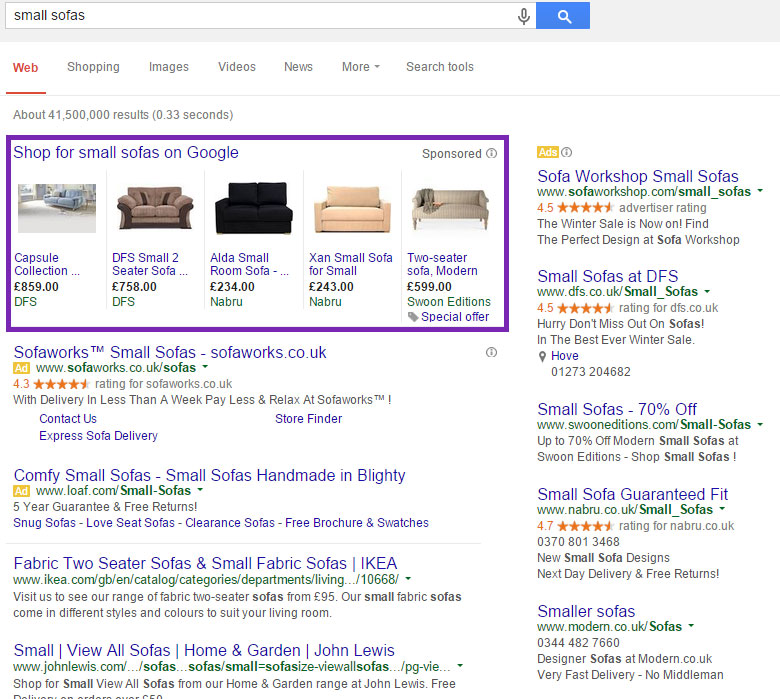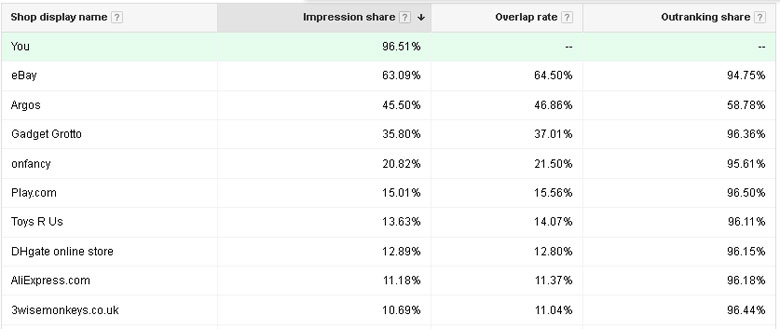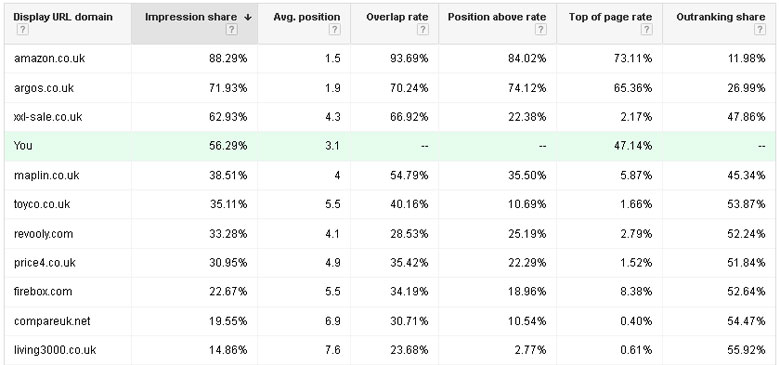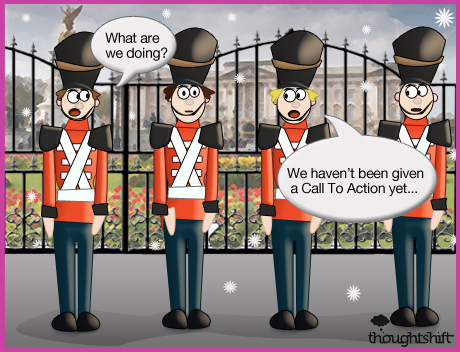RKG released a report recently, which brought to light a very interesting trend; in Q4 2014, for the first time, Product Listing Ads (PLAs – the ad format from Google Shopping campaigns in Google AdWords) drove more non-brand traffic to retailers than traditional text ads. To be more exact, 56% of non-brand clicks were from PLA ads and therefore only 44% of clicks came from text ads, highlighting an undeniable trend in eCommerce PPC.
Why has this change happened?
There are quite a few reasons why this has happened. Firstly, when Google started their forage into PLA listings they generally speaking either sandwiched the ads between the organic and paid results, or shoved above the ads on the right hand side of the page and for obvious reasons they did not generate a huge amount of traffic. Recently though, Google has given more prominence to PLAs by moving them above the paid results for an increasing number of search queries where they will naturally attract more clicks.

Secondly, the way these campaigns are set up (for those not the know, for Google Shopping campaigns you don’t choose which keywords you appear for as you do for a traditional AdWords campaign, rather you appear for search queries that Google deems your products are relevant for) there are now potentially millions of search queries that PLA ads appear for that text ads don’t. This has naturally increased the number of potential clicks PLAs drive to websites.
Lastly, PLA ads are a significantly richer and more accurate ads; they contain images, accurate pricing and are guaranteed to head straight to the product page. In essence they are a far more reliable ad than text ads. As users have become more comfortable with their existence, it stands to reason that as their experience was better than from a text ad, they will now click more on the ad format that they trust the most i.e. PLA ads.
With this in mind, the reasons why Google has increase PLA ads exposure is obvious; they equal more revenue. And as already discussed, PLAs are also evidently good for the user, otherwise this trend would not have occurred, so the remaining questions is…
…Are Google PLA ads better than text ads for advertisers?
I have been intrigued by this question ever since the upgrade to Google Shopping so in December 2014 I decided to run a few tests on one of our eCommerce clients to test some of my theories.
The following table shows the number of clicks, the CTR, the avg. CPC and the eCommerce rate for the same search query from both text ads and PLA ads:
| PLA | Text ads | Variance | |
|---|---|---|---|
| Clicks | 121 | 167 | -28% |
| CTR | 5.30% | 4.97% | 7% |
| Avg. CPC | £0.37 | £0.67 | -45% |
| eCommerce rate | 3.36% | 1.13% | 197% |
The results speak for themselves really; the PLA ads were not only 45% cheaper they also converted 197% higher. Pretty staggering really – I should point out at this stage that I ran the test for several keywords with similar results, however, for space and time reasons I have only included this particular search query. The next question that logically follows for me, is why?
Why is the avg. CPC cheaper?
This was a pretty simple one to cover off now that you are able to see auction insights for Google Shopping campaigns.
PLA auction insights:

Google Search Auction Insights:

I was expecting to see a lower number of competitors in the Google Shopping auction but not quite to this extent – there just simply isn’t the same number of competitors using Google Shopping, and those that are do not have the same ad coverage. As the number of competitors in the auction and how aggressively they are bidding is the single biggest driver of a higher avg. CPC, Google Shopping will obviously have a lower CPC just from looking at the data above.
The extent of the difference in competition between the two auctions will, in all likelihood, vary from industry to industry and search query to search query, however, my gut feeling is that because the barriers to entering the Google Shopping auction (where you need a feed, a website and money) are a lot higher than the search auction (where you only need a website and some money) a click from a PLA ad will pretty much always be cheaper than a click from a text ad for the same search query.
Great, so why is the eCommerce rate higher?
This one is a slightly harder question to answer and is more of a gut feel from me rather than an answer routed from data. I should highlight that in order to get a more accurate result I ensured that both ad types went to the same URL and included the same price of the product which eliminates any landing page or price reasons for a higher eCommerce rate from PLA ads.
My answer then is that users who click on a PLA simply have a higher propensity to buy than those users who click on a search ad. My logic being that if you are researching a product you are more likely to select a text link as you would presume that this text link would give you lots of information about that product. Similarly if you are looking to buy the product you are more likely to click on a richer ad that contains both an image and a price as you would presume this will take you directly to the product page and it will be a shorter journey for you to buy it.
So are PLA’s good for advertisers?
The conclusion is a pretty simple one, it would seem that if you are able to get a feed and advertise on Google Shopping then you should, as it is a considerably better ad format for delivering an ROI than traditional text ads.
So should I start advertising on Google Shopping?
This is an entirely separate question and the answer should be mutually exclusive to the previous questions. You should consider whether you can cheaply and time effectively create a feed and factor this cost into your ROI.
If you can create a feed easily then I would suggest that you take some time to understand how Google Shopping works and spend time to create a campaign structure in Google that will help you deliver your business goals.
If you already have a feed and a campaign running, from my experience there are very few well run Google Shopping campaigns and you should consider the following:
- Am I getting a low impression share for all my best selling products?
- Have I included products in my feed that drive me no profit whatsoever?
- Have I included products in my feed that we do not traditionally sell and I would never dream of marketing?
If yes to any of these I would suggest there are vast improvements that can be made to your campaign. My advice? Use AdWords best practices for Google Shopping campaigns and get ahead of the curve, as we are at ThoughtShift, for our eCommerce clients who use Google Shopping.
Follow my contributions to the blog to find out more about paid search or sign up to the ThoughtShift Guest List, our monthly email, to keep up-to-date on all our blogposts, guides and events.





